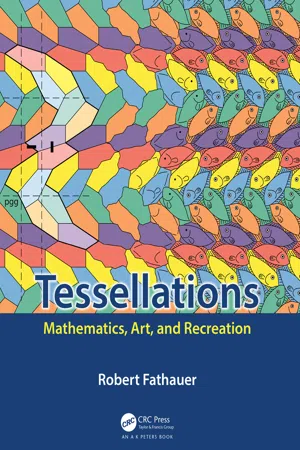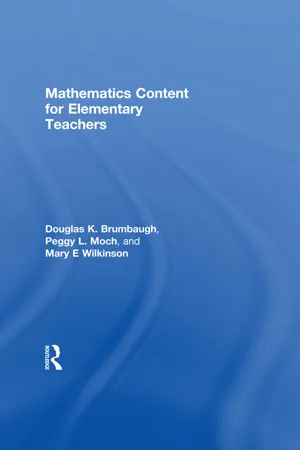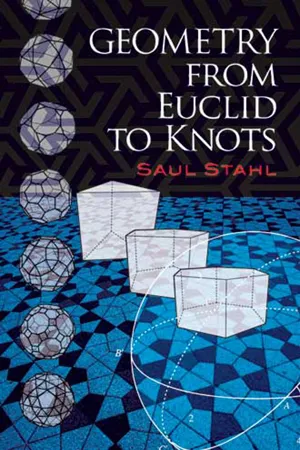Mathematics
Regular Polygon
A regular polygon is a closed shape with straight sides where all angles and sides are equal. It is a type of polygon that has all its interior angles and side lengths congruent. Examples of regular polygons include the equilateral triangle, square, and regular pentagon. Regular polygons are commonly studied in geometry and have properties that make them useful in various mathematical applications.
Written by Perlego with AI-assistance
Related key terms
3 Key excerpts on "Regular Polygon"
- eBook - ePub
Tessellations
Mathematics, Art, and Recreation
- Robert Fathauer(Author)
- 2020(Publication Date)
- A K Peters/CRC Press(Publisher)
Figure 2.1. Three examples of things that are not tiles. (a) A collection of unconnected shapes; (b) two shapes touching at a point; (c) a shape with a hole in it.A polygon is a closed plane figure made up of straight-line segments . For a polygonal tile, the individual segments are referred to as edges , and the points where two edges meet are referred to as corners (Figure 2.1 ). Examples of tiles that are not polygonal are shown in Figure 2.3 .Figure 2.2. A polygonal tile has a boundary consisting of edges and corners.Figure 2.3. Besides being polygons, tiles can have no straight lines or a mixture of straight and curved lines.Angles
For a polygonal tile, the angle between two adjacent edges inside the tile is called the interior angle . The angle between the same two edges outside the tile is called the exterior angle . A full revolution measures 360° (Figure 2.4 ). As a result, for any two adjacent edges of a tile, the interior and exterior angles always sum to 360°. Some common angles encountered in tessellations, particularly those of Regular Polygons, are shown in Figure 2.5 . Each angle is specified in three different ways: in degrees, as a fraction of π, and as a fraction of a full revolution. A full revolution equals 360° or 2π. These comments about angles pertain to the Euclidean plane , the two-dimensional geometric space students learn about in K–12 education. Unless otherwise stated, tessellations in this book should be understood to live in this space.Figure 2.4. The interior and exterior angles between two adjacent edges sum to 360°.Figure 2.5. Common angles in tessellations.Vertices and edge-to-edge tessellations
A point at which three or more tiles meet is called a vertex (Figure 2.6 ). The sums of the interior angles of the tiles meeting at a vertex must be 360°, which is a full revolution. The number of tiles meeting at a vertex is the - eBook - ePub
- Douglas K. Brumbaugh, Peggy L. Moch, MaryE Wilkinson(Authors)
- 2004(Publication Date)
- Routledge(Publisher)
at F. The sides of ABCD are congruent in pairs, thus you will see that the height of the polygon depends on your orientation as you view the sketch.Your Turn 15. Write an informal definition for each term. a) Side of a polygon—How many sides does a 12-gon have? b) Vertices of a polygon—How many vertices does a 7-gon have? c) Diagonal of a polygon—How many diagonals does a 5-gon have? d) Altitude of a polygon—How many altitudes does a 3-gon have? CirclesFig. 4.17.Some people consider a circle to be a special polygon—with an infinite number of infinitely short sides. Others prefer to put the circle in a special category all its own. Because a circle is a simple closed curve, it divides the plane into three sets of points (inside the circle, outside the circle, and on the circle). When you used a piece of string to model the polygons in Table 4.1 , did your model start to look a bit like a circle as you added more and more sides without changing the length of the string? It is easy to see the connection with polygons. However, as you look at circles, such as the one shown in Fig. 4.18 , you do not see infinitely short sides, only smooth and perfectly rounded curves, making it easy to argue that circles should have their own category.Fig. 4.18.Sometimes people refer to circular pieces of material as circles—perhaps a coin, poker chip, or other disk. In fact, these items are right circular cylinders; they may be very short cylinders, but they are not figures in a plane and they have more dimensions than do circles. A circle is a point and every member of the set of points is the exact same distance from the center in the plane. The circular array of points is the circumference of the circle. The circle is the ring. The set of points inside the ring is not the circle; it is the interior of the circle. Similarly, the points outside the ring are not the circle; they make up the exterior of the circle. A circle has no substance, so the best way to model a circle is with a wire ring. Of course, the wire of the ring has thickness, but it represents a much better model of a circle than a solid plastic disk. - eBook - ePub
- Saul Stahl(Author)
- 2012(Publication Date)
- Dover Publications(Publisher)
(Fig. 4.16) .TO CONSTRUCT: Points A, B, C, D, E on p such that ABCDE is a regular pentagon.Figure 4.16.CONSTRUCTION: At the center O of the circle construct five nonoverlapping central angles of 72° [PN 4.3.3] . Label the successive intersections of their sides with the circle A, B, C, D, E. Then ABCDE is the required pentagon.PROOF: The five constructed isosceles triangles are all congruent by SAS. It follows that the five sides AB, BC, CD, DE, and EA are all equal. Moreover, the base angles of these triangles are (1/2)(180° − 72°) = 54° each and hence all of the pentagon's interior angles are equal (to 108° each).Q.E.D.Euclid took the trouble to prove that the regular 15-sided polygon is constructible (Exercise 3). It is reasonable to suppose that this was his way of pointing out that there is an interesting question to be pondered here. Namely, for which integers n can the regular n-sided polygon be constructed? It has already been shown above that this is possible for n = 3, 4, 5, 6. Some more such n can be easily produced by simply doubling the number of sides of any constructible Regular Polygon (see Exercises 1 , 2 , 4 ). However, this does not answer the question for such numbers as 7, 9, 11, 13, 14, 17, . . . . The surprising intricacy of the construction of the regular pentagon indicates that such polygons might pose an even greater challenge. This problem continued to excite the interest of mathematicians after Euclid, but no progress was made for over 2000 years until the young Gauss demonstrated the constructibility of the regular 17-sided polygon in 1796. Actually, he did much more. Using the newly emergent theory of complex numbers Gauss proved that a regular p-sided polygon can be constructed for every prime integer p that has the form for some nonnegative integer n
Index pages curate the most relevant extracts from our library of academic textbooks. They’ve been created using an in-house natural language model (NLM), each adding context and meaning to key research topics.


